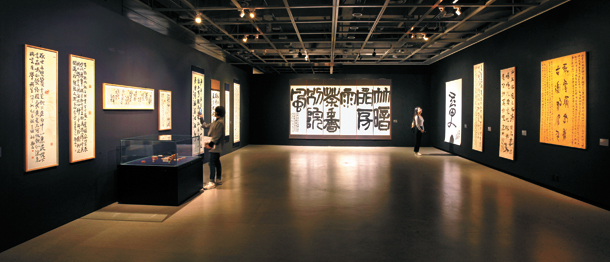Celebrating the fading art of brush and ink: The Seoul Arts Center looks to the past and future to revive Korean calligraphy

The "SAC Calligraphy Festival" exhibition at the Calligraphy Art Museum of the Seoul Arts Center in southern Seoul will run though Sunday. Visitors look at works on display. [PARK SANG-MOON]
As the importance of ink and brushes has faded over the centuries, so has calligraphy’s prominence. The ballpoint pen may not be able to produce such unmistakable aesthetics, but it’s also a lot more convenient. The last university calligraphy department in Korea, at Wonkwang University, shut down earlier this year.
Yet young calligraphers devoted to keeping the traditional field alive have come together at the “SAC Calligraphy Festival 2018: The Future of Korean Calligraphy Art” exhibition at the Seoul Arts Center (SAC) in southern Seoul, which is set to open until this Sunday.
The exhibit features a total of 121 works by 49 calligraphers between the ages of 20 and 50, each displaying a side of the art in a different light. Some works are faithful to the most classical form of Korean calligraphy, which descended from the historical Chinese characters, but others use hangul and abstract painting. The exhibition is a chance to experience the long-forgotten beauty of calligraphy.
The exhibition is a part of the “SAC Calligraphy Festival” series, which the center is hosting together with the Korean Federation of Seo-ye Associations to bring calligraphy closer to the general public.
The series started last year with the “SAC Calligraphy Festival 2017” exhibition, which featured works by 130 leading figures in the Korean calligraphy scene. This year’s exhibition is comprised of artists who were chosen through an open call in June.
Because the open call was not limited to any particular genre of calligraphy, the exhibition includes a wide array of works of diverse contents and styles. The exhibition is divided into three main parts: the past, present and future of calligraphy, ultimately opening up the question of where the future of Korean calligraphy lies.

The exhibition features calligraphy works of various styles, ranging from traditional and classical styles of calligraphy that feature only letters and minimal pictures, to those that push the boundaries of calligraphy by exploring diverse styles. Above are works on display at the exhibition, all of which are new pieces that were submitted through an open call for work this June. From left, Park Se-ho's "108 Pensive Bodhisattva," Noh Jae-jun's "The Road Not Taken," Lee Do-young's "The Spring News of Namdo" and Woo Do-gyu's "Ants." [SEOUL ARTS CENTER]
The exhibition begins with works that hew to the classical style of calligraphy, with nothing but writing so that the different styles and fonts of the characters become the sole subject, or ink paintings that keep to the traditional landscape style and depict trees or flowers. Works by 19 artists sit in this section.
On the walls of the present section are pieces by 16 artists who experiment with different styles, using both text and pictures for the formative structure.
Such creative works include Lee Do-young’s “The Spring News of Namdo” and Woo Do-gyu’s “Ants.” They allow visitors to enjoy their works without fully comprehending the text, but simply by enjoying the harmony of letters and pictures presented together in a single form.
In the last section, the future, visitors are invited to see how calligraphy has the potential to reach the contemporary art world through the works of 14 artists who have experimented with the discipline. Visitors are confronted with questions on the nature of calligraphy. Few clear answers arise from the boundary-pushing pieces.
Noh Jae-jun’s “The Road Not Taken” which features both Korean and English - the only work in the exhibition to do so - and Park Se-ho’s “108 Pensive Bodhisattva” which is a painting formed by Chinese letters in which each letter serves as a component of the whole image.
The graffiti section features contemporary works by 16 artists: John Matos Crash, JonOne, Shepard Fairey, ZEVS, L’Atlas, MadC, Fabien Verschaere, Nasty, Nasty&Seth, Vhils, Ladislas Kijno, Sun7, Tanc, Fenx, Darco and M.Chat.
“As you all know, the future of Korean calligraphy is not as bright as we hope it would be,” said Ko Hak-chan, the president of the SAC, during the exhibition’s opening on Sept. 21. “Because all calligraphy departments have been shut down, we can’t learn it even if we wanted to. In this situation, an exhibition like this shines ever more brightly. It is with the young generation that we will see where the future is heading. We may want different things, but for the field of calligraphy, we must come and work for the future together.”
BY YOON SO-YEON [yoon.soyeon@joongang.co.kr]
The exhibition runs until Sunday at the SAC’s Calligraphy Art Museum in Seocho District, southern Seoul. Admission is 5,000 won ($4.42) for adults and 3,000 won for seniors aged 65 and over or children under the age of 18. For more information, call (02) 580-1300 or visit www.sac.or.kr










with the Korea JoongAng Daily
To write comments, please log in to one of the accounts.
Standards Board Policy (0/250자)